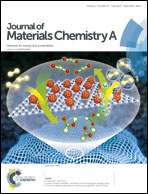The impact of size effects on the electrochemical behaviour of Cu2O-coated Cu nanopillars for advanced Li-ion microbatteries†
Abstract
The generation of a distribution of nanoparticles upon conversion reaction of thin Cu2O layers is demonstrated to produce a wide electrochemical potential window, as well as a distinctive capacity increase in large area three-dimensional electrodes. Cu nanopillars with a 10–15 nm Cu2O coating containing traces of nanocrystalline Fe2O3 yield capacities up to 0.265 mA h cm−2 (at 61 mA g−1), excellent cycling for more than 300 cycles and an electroactive potential window larger than 2 V, due to the size effects caused by the various Cu/Cu2O nanoparticles formed during conversion/deconversion. These 3D Li-ion battery electrodes based on electrodeposited Cu nanopillars spontaneously coated with a Cu2O layer are compatible with current densities of 16 A g−1 (i.e. 61 C rates) after aerosol-assisted infiltration with an iron acetate solution followed by low-temperature pyrolysis. The capacity of the composite material increases by 67% during 390 cycles due to the growth of the electroactive area during the electrochemical milling of Cu2O forced by its repeated conversion/de-conversion. The latter generates a distribution of nanoparticles with different sizes and redox potentials, which explains the broad potential window, as well as the significant capacity contribution from double layer charging. These 3D electrodes should be well-suited for Li-ion microbatteries and Li-ion batteries in general, since they combine high capacities per footprint area with excellent power capabilities. More importantly, such electrodes grant access to fundamental understanding of the electrochemical behaviour of these active materials providing new insights into both conversion mechanisms and nanostructured interfaces more in general.


 Please wait while we load your content...
Please wait while we load your content...